There were only 500 apps on the App Store when it launched with the release of the iPhone in 2008. Back then, the mobile app market was worth just $206 million.
Fast forward to 2023, when 1.96 million apps are available on the App Store and consumers are predicted to spend $33.9 billion in app stores.
Moreover, as many as 86% of people use other devices while watching TV, with between 68%-76% of viewers using a smartphone to research information, use social media, and reply to messages.
Taking all that into consideration, in-app mobile advertising presents a great opportunity for advertisers. With many of us being so dependent on mobile devices, using mobile advertising to reach a target audience is a no-brainer for marketers and advertisers.
In this article, you will learn about mobile advertising, how it’s different from in-app advertising, and how in-app advertising works
Key Points
- In-app (aka, mobile app) advertising refers to displaying ads within mobile apps on smartphones and tablets.
- Mobile apps serve ads through the use of a software-development kit (SDK), meaning that developers have to integrate the given AdTech vendor’s SDK into their app.
- Gaming, social, utility, and entertainment companies rely heavily on in-app advertising (IAA) to generate revenue.
- As app developers get paid to serve advertisements within their mobile app, in-app advertising allows publishers to keep their content free for users, boosting downloads while earning scalable revenue.
- Nowadays, the app economy is dominated by free-to-download apps, with only a small portion (~5%) of users making in-app purchases (IAP) and generating revenue for apps.
- According to data.ai’s research, time spent on Android phones per day has reached 5 hours in the top mobile-first markets, along with the number of app downloads hitting 255 billion in 2022, with global consumers downloading more than 485,000 apps per minute.
- The main types of in-app ad formats include playable ads, interstitial ads, offerwalls, rewarded video ads, video ads, expandable ads, standard banner ads, and native ads.
The Growth of Mobile Advertising
These are just some of the events that have shaped mobile advertising into what it is today:
- Although the handheld mobile phone was developed in 1973, it wasn’t until 1992 that the first text message was sent.
- It was only in 1997 that free news headlines via short message service (SMS) were offered by a Finnish news provider.
- The first phone used for email was released in 1999.
- Mobile marketing came to life in 2000 when the Wireless Advertising Association in New York and the Wireless Marketing Association in London were created around the same time; together, they transformed into the Mobile Marketing Association in 2003.
- 2006 brought AdMob, the first leading mobile advertising platform, thus giving web developers and publishers the possibility to monetize mobile ads.
- Introduced to the public in 2007, Google’s Mobile AdSense allowed websites optimized for mobile browsers to display the same ads as a regular website.
- Before AdSense was released, the launch date of the first iPhone was announced in early 2007.
- iPad went on sale in 2010, and a few days afterwards, Apple introduced their advertising platform, iAD.
- Facebook’s Mobile Ads was launched in 2012. Prior to this launch, Facebook garnered no revenue from the mobile app because no advertising was available.
The release of the first iPhone in 2007 totally changed the game for mobile advertising, giving users the option to interact with a mobile ad in a new way: the touch-sensitive, multi-sensor interface enabled ads to to be shrunken or enlarged, as well as rotated.
Considering that people use apps for all sorts of things, it’s not surprising that time spent “in-app” keeps increasing year-on-year (YOY).
However, users tend to spend more time in-app compared to on the mobile web these days, so although marketers and advertisers have more hours and ways to reach them each day, they have to think of innovative ways to actually catch the attention of their target audience.
Evidence of this behavior is illustrated in the following statistics from Data.ai’s State of Mobile 2022 report:
- Time spent on Android phones per day has increased to 5 hours in the top mobile-first markets.
- App downloads reached 255 billion in 2022, with global consumers downloading more than 485,000 apps per minute.
- Mobile ad spend is predicted to get as high as $362 billion in 2023, despite tightening marketing budgets.
- What’s concerning is that the App Store spend has cooled to $167 billion (-2% YoY) due to a decline in gaming spend, which was previously bolstered by pandemic conditions.
AdTech & Programmatic Platform Development
We can help you design and build real-time bidding, and programmatic advertising platforms for all advertising channels — display and native, in-app mobile, video and audio, OTT and CTV, in-game and DOOH.
What Is In-App Advertising?
In-app advertising, aka mobile-app advertising, refers to displaying ads within mobile apps on smartphones and tablets. Brands and advertisers run ad campaigns across multiple mobile apps to increase brand awareness and conversions, just like they do with other digital advertising channels, such as web advertising.
Gaming, social, utility, and entertainment companies are quite dependent on in-app advertising (IAA).
Since app developers get paid to serve advertisements within their mobile app, publishers can keep their content free for users.
Not only does this model keep content free, but it also drives the number of downloads up, as well as providing scalable revenue for app developers and publishers.
Currently, it’s rather rare for apps to require payment up front, as most have a freemium model that lets you download the software for free with the option to upgrade later in order to be able to use more features, remove ads, have access to more content, or buy stuff.
Moreover, only a small portion (~5%) of users decide to make in-app purchases (IAP) and, therefore, generate revenue.
There are apps that are capable of relying on IAP alone, but most of them prefer to use ad revenue from in-app advertising (IAA) as their main revenue stream.
Now that we’ve got the definition of in-app advertising out of the way, let’s move on to how in-app ads work.
How Are In-App Ads Served?
Mobile apps need to use a software-development kit (SDK) in order to display ads, meaning that developers have to integrate the given AdTech vendor’s SDK into their app. In terms of how ads are shown, it’s done through an AdTech platform, such as a mobile ad network.
An ad network is a platform that brings developers and advertisers together.
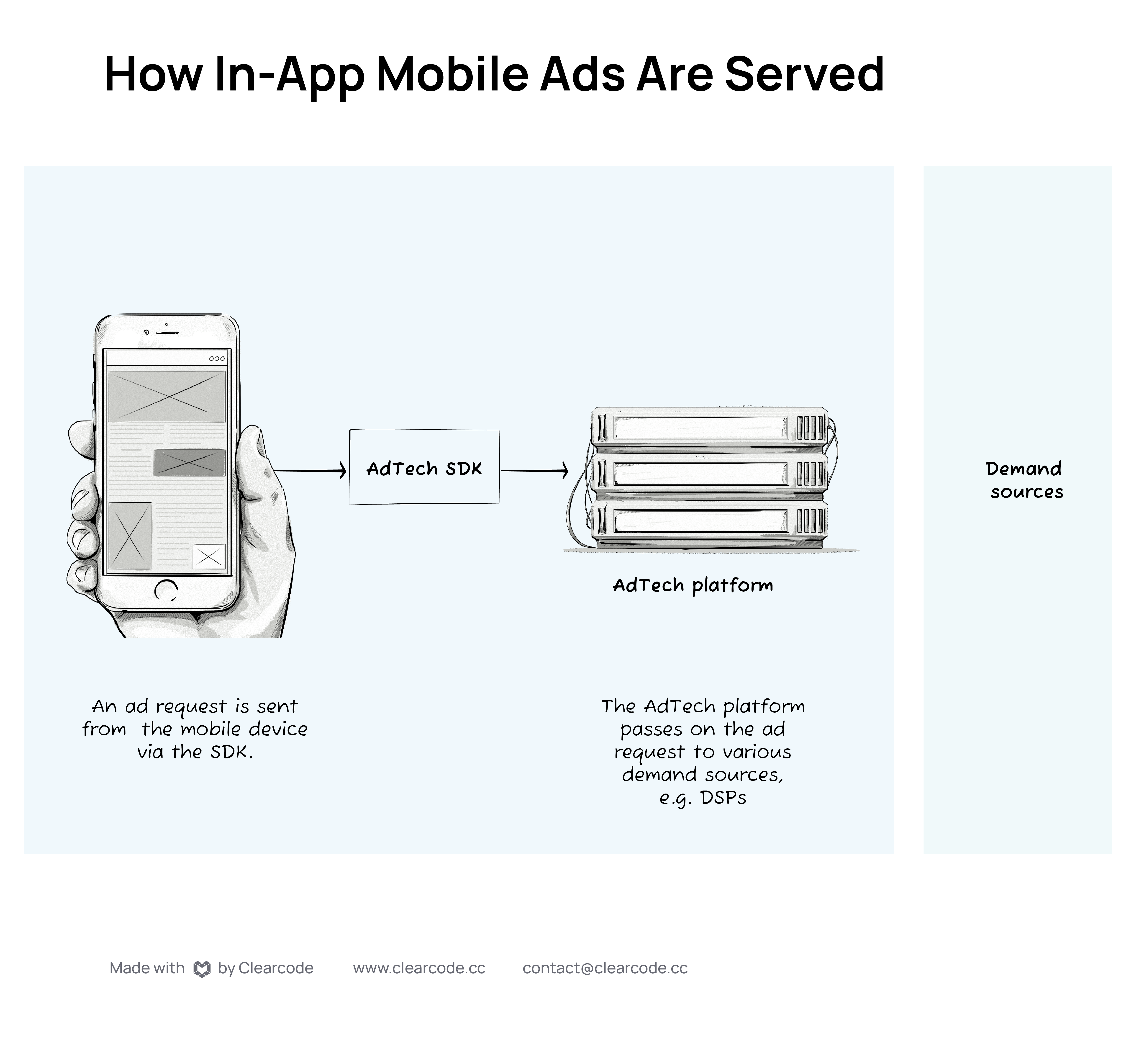
Due to constant changes in formats, programmatic ad buying, and real-time bidding, developers are now able to automate and handle ads more efficiently than in the past.
In addition, ads have undergone advancements to enhance intuitiveness and seamless integration within the mobile user experience.
Like all the other digital advertising channels, the in-app mobile advertising ecosystem is divided into the buy side and the sell side, with various advertising technology (AdTech) platforms playing a key role in the delivery and measurement of in-app ads.
The buy side consists of stakeholders buying the ads. These are app developers and agencies who are responsible for designing mobile ads, coming up with a campaign strategy, and then launching the ad campaign.
The sell side, on the other hand, is made of apps selling ad space, known as publishers, with app publishers (developers) combining a mediation platform with various ad networks through a software development kit (SDK).
An ad network acts as a broker, meaning that it takes care of selling the publishers’ in-app inventory to the advertisers, along with handling the process of matching a publisher’s ad supply with the advertiser’s demand.
Apart from the ad network, we’ve also got the ad exchange.
An ad exchange resembles a stock exchange, so instead of simply selling impressions by the thousand, the ad exchange lets advertisers select their desired audience and bid on individual impressions.
Two other key AdTech platforms are the demand-side platform (DSP) and the supply-side platform (SSP).
The former gives advertisers access to inventory from numerous ad exchanges, while the latter lets publishers manage their in-app ad inventory and make it available to advertisers via an ad exchange and DSP.
So, how does the whole system work exactly?
Well, it depends on how the in-app mobile ads are bought and sold.
If an ad is being transacted via an ad network, then an ad request will be sent from the mobile app to an ad network via an SDK. The ad request will be matched with an advertiser’s campaign, and an ad will be selected. The ad will then be sent back to the mobile app and displayed to the user.
If the ad is being transacted via real-time bidding (RTB), then an ad request will be sent from the mobile app to an SSP via an SDK. The SSP will then pass on the ad request to an ad exchange, which will then pass on the bid request to multiple DSPs.
Each DSP will evaluate the bid request, match it with the advertisers’ ad campaigns, and send back a bid response. The ad exchange will then hold an auction where each of the bids from the various DSPs will compete against one another.
The highest bid will win the impression, and the ad will be shown to the user.
Below is an overview of how in-app mobile ads are bought and sold via ad networks and RTB.
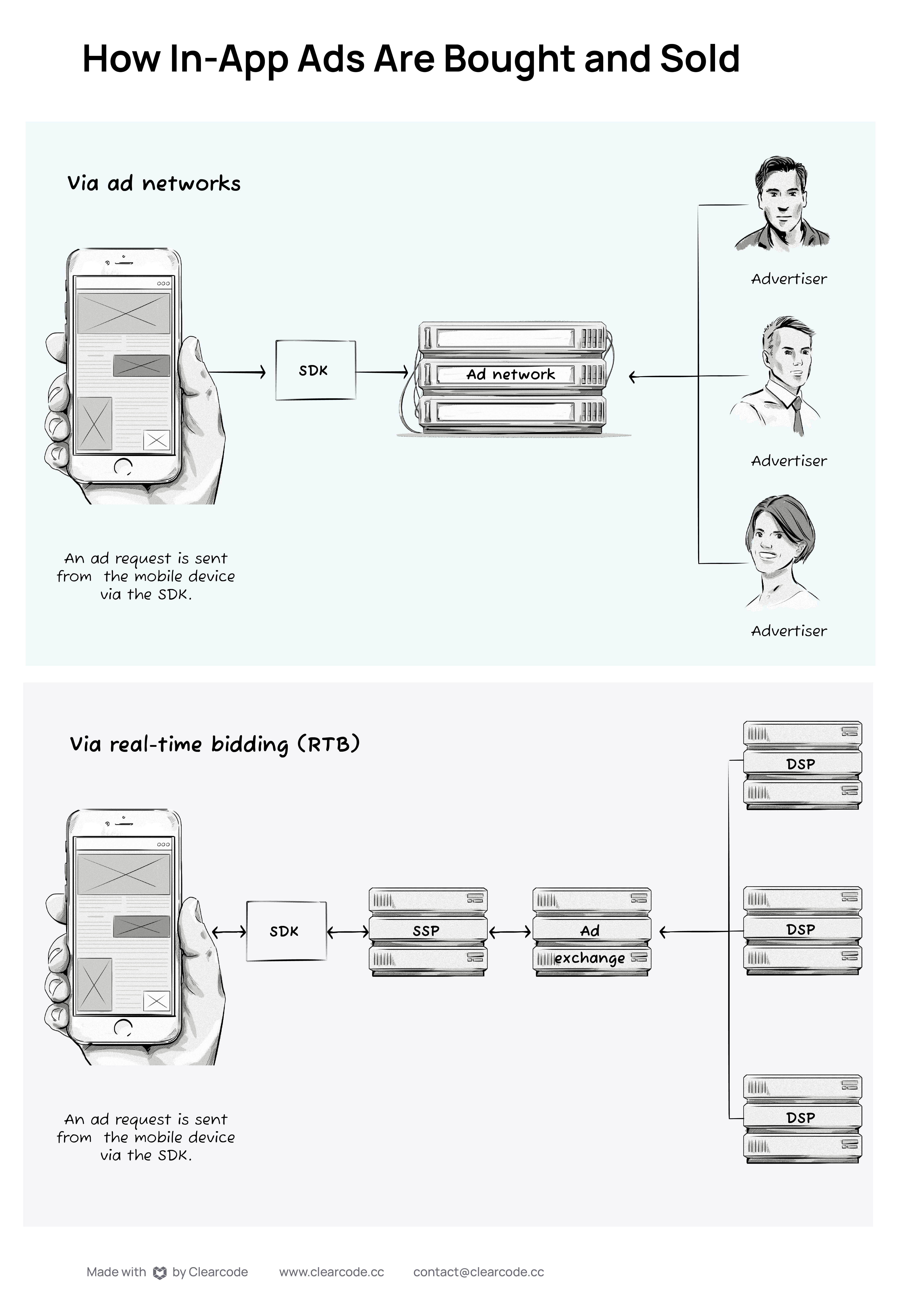
What’s the Difference Between In-App Advertising and Mobile Advertising?
Here’s a short comparison between mobile and in-app advertising:

Now, let’s see exactly how these two types of advertising can be differentiated.
When it comes to mobile devices using a browser to display ads, they don’t require a software-development kit (SDK), as these ads are served in the same way as ads on websites.
Mobile apps, on the other hand, need the mobile app’s developers to integrate the given AdTech vendor’s SDK into their app so that the ad space where the ads will run is defined, along with information about the ad medium (e.g., text, image, native, and video) and the ad format (e.g., interstitial and banner).
Despite less time being spent on the mobile web compared to in-app activity, the mobile web offers more contextual- and audience-targeting opportunities, due to the fact that new web pages are being created all the time.
Thanks to that, advertisers are capable of reaching audiences based on their interests across the whole Internet, making the mobile web a huge opportunity for advertisers in terms of scale.
There’s also the matter of available formats.
Most ad formats adjust well to the mobile web — whether it’s native ads that seamlessly blend into their surrounding content, or video ads, which are a useful weapon for battling “banner blindness”.
What’s also important to mention is viewability. Based on research from eMarketer, the global viewability rate is much higher in-app than for either the mobile web or desktop:

It’s all due to the fact that ads shown in apps are better at capturing one’s attention, as they are often more prominent and can’t be closed as easily as ads displayed in a browser.
It’s also worth pointing out that desktop and laptop computers might be shared, whereas mobile phones generally only have one owner, so installed apps have a thorough personal connection with the user and their daily habits, making the in-app environment a perfect space for creating effective and personal advertising touchpoints.
Examples of In-App Ad Formats
There’s no right or wrong answer as to which in-app ad format you should choose to get your desired results, but you can certainly find one that is suitable for your needs.
The best way to do this is by deciding what you’re aiming to achieve with your campaign.
Each type of in-app ad offers various useful benefits, so let’s explore them to know what they bring to the table.
Playable Ads
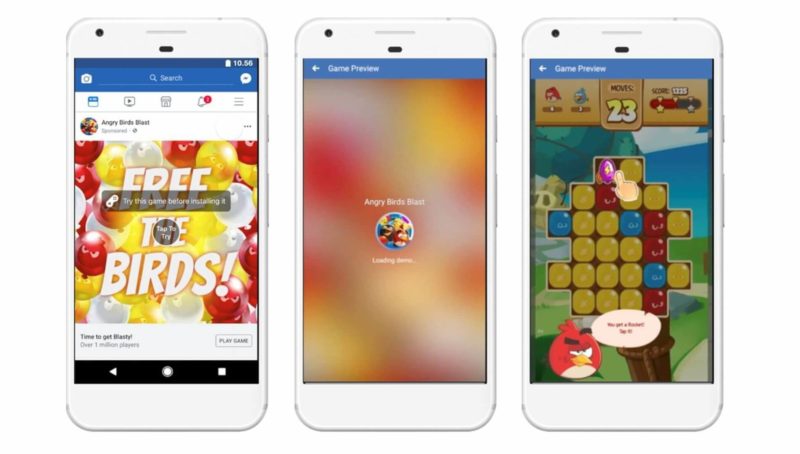
Playable ads are like app “samples,” as they allow users to try out the software through all sorts of mini-games before installing it.
Since these ads are interactive, they tend to be received positively by the audience, provide a good user experience, and deliver the highest eCPMs in the industry.
Interstitial Ads

Interstitial ads provide users with rich, customizable, and appealing static or in-app video ads at natural pauses in an app’s flow, such as when a user opens the app, browses between pages, or switches between games. This frequency of ad exposure keeps the disruption of the user experience to a bare minimum.
They do, however, require user action in order to be closed or display the desired content.
One of the most distinguishable interstitial ads is a splash ad, a full-screen interstitial ad shown when the app is opened but before any other content is loaded.
Offerwalls

Offerwalls are essentially mini-stores within the app.
They mainly present a list of tasks that users can do and in exchange for an in-app reward.
The user has to initiate this type of ad, which extends session length; hence, they hold a dominant position among eCPMs.
Rewarded Video Ads

With rewarded video ads, users receive various prizes for watching a video.
Not only are they displayed voluntarily, but they also boost in-app purchases and encourage users to come back.
Video Ads
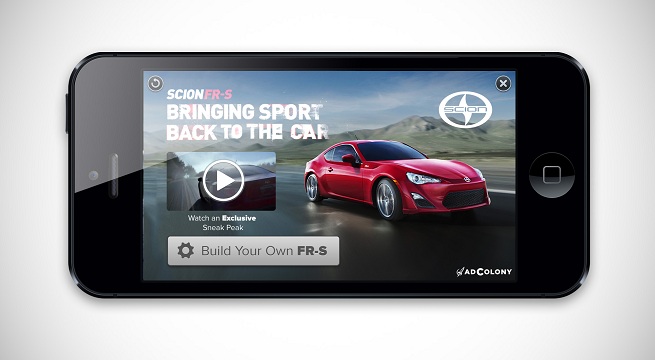
In-app video ads last between 15 and 30 seconds.
Moreover, compared to desktop ads, users pay more attention to in-app video ads because, without the ability to multitask, their attention is solely directed toward the ad.
Expandable Ads

Although expandable ads are usually rich media ads, they are also considered a mix of banner and interstitial ads.
Starting with a teaser banner (320×50 pixels), they then expand to 320×480 pixels after being clicked on by the user. The enlarged version of the ad gives advertisers more space to deliver the message they are trying to convey in the ad.
Standard Banner Ads
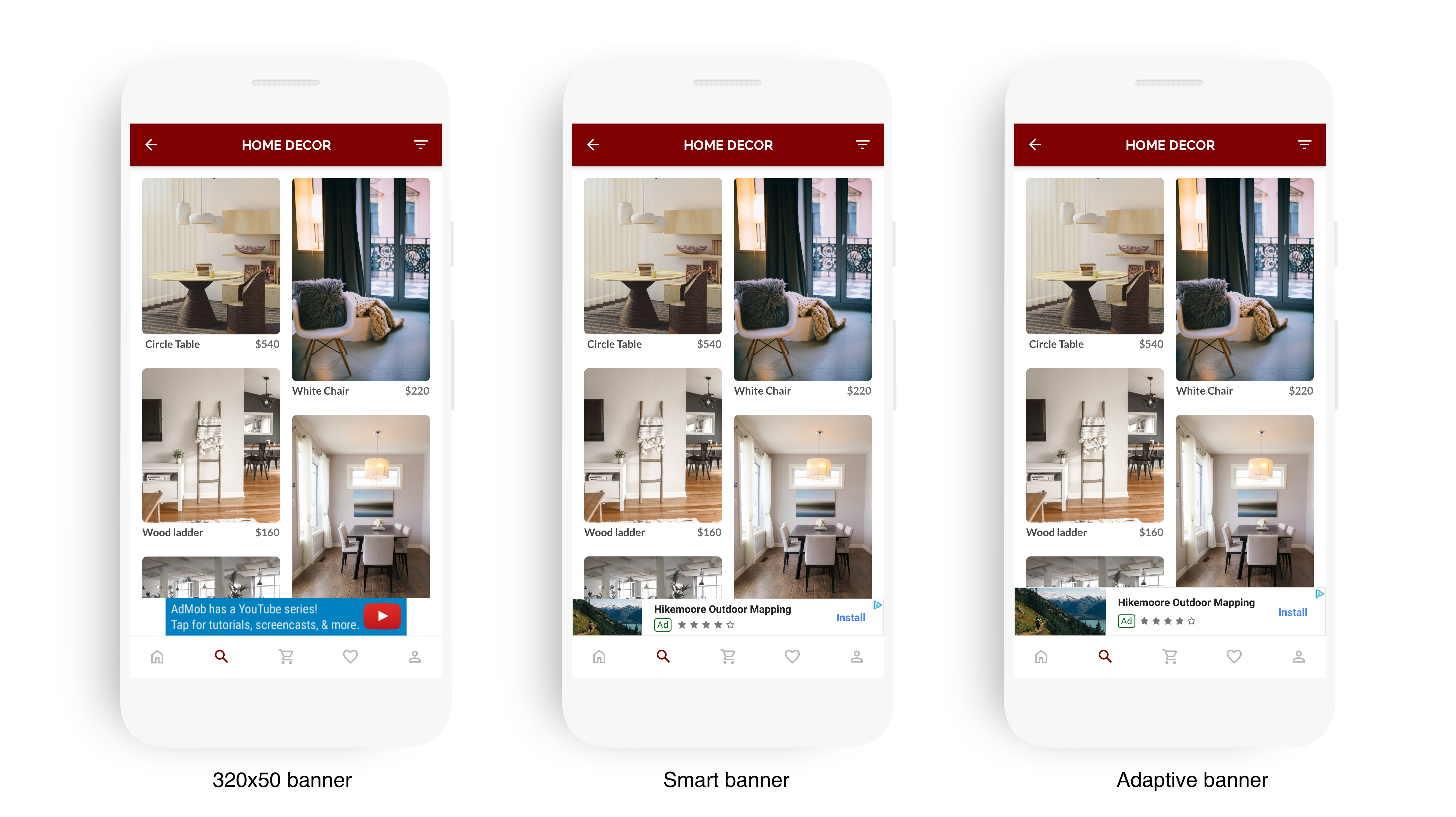
Standard banner ads vary from 320×50 to 300×50 pixels, and they’re usually static or animated. Moreover, they commonly appear at the top or bottom of the screen.
Despite being fairly simple, this is the most popular advertising format.
Back in the day, these ads weren’t quite effective, but if implemented in the right context, they’re passive and non-intrusive; thus, they contribute to user experience satisfaction.
Native Ads
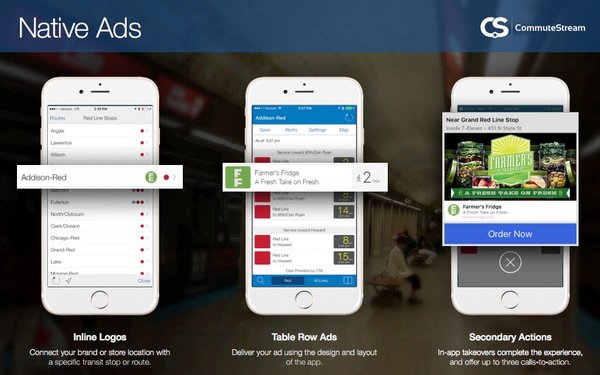
Overall, native ads combine advertising messages with user-centric content.
As publishers aren’t given an actual ad but rather the components of the ad, they’re the ones deciding how to display the element in ways that fit well with its app, meaning that there’s no one established standard in terms of form and size.
AdTech & Programmatic Platform Development
We can help you design and build real-time bidding, and programmatic advertising platforms for all advertising channels — display and native, in-app mobile, video and audio, OTT and CTV, in-game and DOOH.








